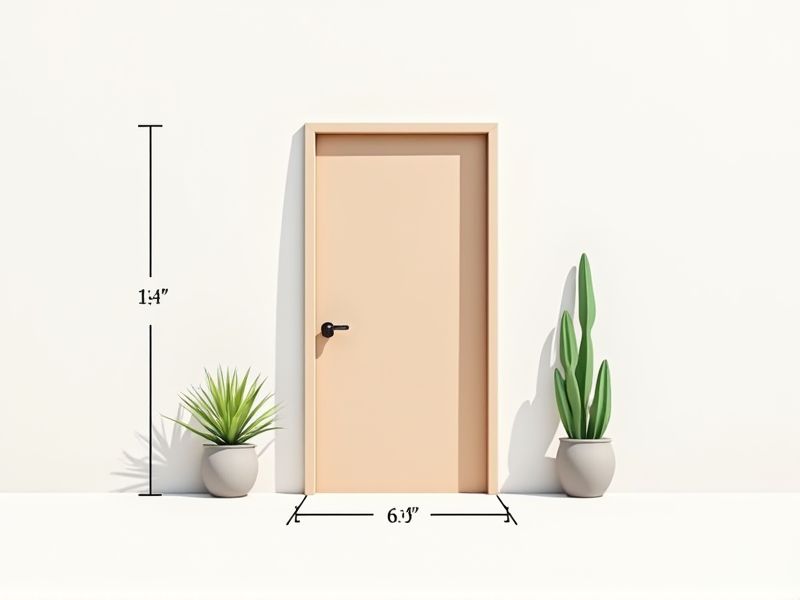
When planning an entryway, it's helpful to know that standard door widths are typically 36 inches, which allows for easy access and is suitable for most homes. The typical height for entry doors is 80 inches, though options as tall as 96 inches are also popular in modern builds. For even more functionality, many homeowners include sidelights or transom windows, which add both light and a sense of spaciousness. Always measure your space and consider traffic flow to ensure your entryway is both welcoming and practical.
Door Width
The standard door width for residential entryways is typically 36 inches, allowing adequate space for movement and accessibility. For homes designed for universal access, a minimum door width of 32 inches is recommended to accommodate wheelchairs and mobility aids. In commercial buildings, the guidelines often stipulate door widths of 44 inches to facilitate smoother traffic flow and compliance with the Americans with Disabilities Act (ADA). Ensuring your door meets these widths is essential for both functionality and safety in any entryway design.
Door Height
The standard door height typically measures 80 inches (203.2 cm), which accommodates the majority of residential and commercial spaces. This height not only ensures accessibility but also aligns with the design aesthetics of modern architecture. When planning your entryway, consider that doors with a height of 84 inches (213.4 cm) are becoming increasingly popular, providing a more spacious appearance. Ensuring the right door height enhances the overall functionality and visual appeal of your entryway.
Threshold Height
The standard threshold height for entryways typically ranges from 1 to 2 inches, allowing for a smooth transition between rooms while preventing water and debris from entering the space. According to building codes, a maximum threshold height of 2 inches is recommended to ensure accessibility for individuals with mobility challenges. Proper installation of the threshold is crucial; it should sit flush with the door and floor to minimize tripping hazards. For optimal energy efficiency, consider using materials that provide insulation while maintaining the appropriate height specifications.
Sidelight Width
The standard entryway width for sidelights typically ranges from 12 to 24 inches on either side of the main door. Sidelights serve both aesthetic and functional purposes, enhancing natural light and visibility while maintaining security. When considering sidelights, ensure the overall entryway width complements your architectural style, as the dimensions can affect the home's curb appeal. You should also factor in local building codes and regulations, which may dictate specific requirements for sidelights in your area.
Door Frame Depth
The door frame depth is crucial for ensuring proper installation and functionality of your entryway. Standard door frame depths typically measure between 4.5 to 6.5 inches, accommodating various wall thicknesses and aesthetic requirements. A deeper frame can enhance insulation, reduce energy costs by minimizing drafts, and improve overall door security. When selecting your door frame, consider the material and style of the door, as they should harmonize with the frame depth for optimal performance and appearance.
Door Jamb Width
The standard door jamb width typically measures 4 to 6 inches, accommodating most entry doors for residential and commercial spaces. Ensuring your door jamb meets these dimensions is crucial for proper installation and functionality. A wider jamb not only enhances structural integrity but also provides increased energy efficiency by minimizing air leaks. Regular checks on your door jamb dimensions can save you from costly repairs and improvements in your property's overall insulation.
Door Swing Clearance
Door swing clearance is crucial for ensuring accessibility and safety in entryway design. The minimum requirement for swing clearance is typically 32 inches, allowing for easy passage for individuals using wheelchairs or mobility aids. In residential settings, a standard door often swings outward, requiring a clear space of 18 inches in front to avoid obstruction. Ensuring proper door swing clearance not only complies with guidelines such as the ADA but also enhances the overall functionality of your entryway space.
Headroom Clearance
A standard entryway should provide a minimum headroom clearance of 6 feet 8 inches to ensure comfortable passage for most individuals. For commercial spaces, the recommended height may rise to 7 feet to accommodate taller guests and equipment. Proper headroom clearance not only enhances accessibility but also complies with various building codes and regulations. When designing your entryway, consider factors like ceiling height and any overhead fixtures to maintain this essential clearance.
Sidelight Height
When designing an entryway, the standard sidelight height typically ranges from 6 feet 8 inches to 8 feet, providing a sense of grandeur and illumination. Sidelights, which are narrow, vertical windows flanking the door, enhance natural light, adding a welcoming ambiance. This height not only complements standard door measurements but also ensures architectural balance, creating an inviting facade for your home. Choosing the appropriate sidelight height can significantly elevate your entryway's aesthetic appeal and functionality.
Overall Unit Dimension
The standard entryway dimensions for residential spaces typically measure between 36 inches wide and 80 inches high, ensuring optimal accessibility. In commercial settings, doorways often expand to a minimum of 48 inches in width to accommodate high foot traffic and accessibility compliance. Overall unit dimensions should also align with building codes, which often require a minimum height of 7 feet to enhance usability and aesthetic appeal. When designing or renovating, you should consider these dimensions to create a welcoming and functional environment that meets both safety standards and design preferences.
